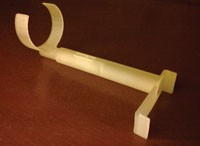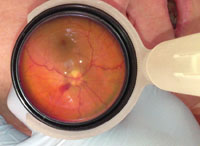 |
 |
| Stanford University doctors created this inexpensive adapter that would even allow non-eye doctors to take images and videos directly from a smartphone. |
The purpose of the adapter is to make it easy for a non-eye doctor to capture a clear picture and immediately share it securely with other practitioners.
Dr. Chang and his colleagues believe this technology will increase eye care services and improve the efficiency of remote patient consults, particularly in urgent medical situations, as well as in rural, isolated and underserved areas.
The adapter is inexpensive—about $100—and uses existing ophthalmic lenses for fundus photos.
By comparison, nonmydriatic cameras, either handheld or desktop, cost in the thousands. “When this is not available, then using a high-quality phone image can help with remote triage and save resources and time, if the liability is covered,” Dr. Chang says.
Other adapters are available to attach a smartphone to a slit lamp. But Dr. Chang sought to develop technology with point-and-shoot capabilities in seconds, not minutes, with instant upload to secure servers. The researchers also wanted a device that could be used properly by any practitioner, not just eye doctors.
“We basically wanted to remove the need for a slit lamp entirely,” Dr. Chang says.
The adapter is currently designed for the iPhone, but they plan to have versions that work with any modern smartphone with a high-quality camera.
“Others have shown you can hold a lens over the eye and take a video with your smartphone to view the retina—we are basically facilitating that same indirect ophthalmoscopy process but without as much hand-eye coordination needed to obtain the clear picture,” Dr. Chang says.
The first prototype was designed to capture images of the anterior segment, but they’ve now made a posterior segment adapter, too. Both adapters should be available soon, Dr. Chang says.
Myung D, Jais A, Lingmin H, et al. Simple, low-cost smartphone adapter for rapid, high quality ocular anterior segment imaging: a photo diary. Journal MTM. 2014 Feb;3(1):2-8.

